
Well Mannered Dog | Charleston Dog Trainer | Charleston Dog Training
Integrate Practice into Everyday Life
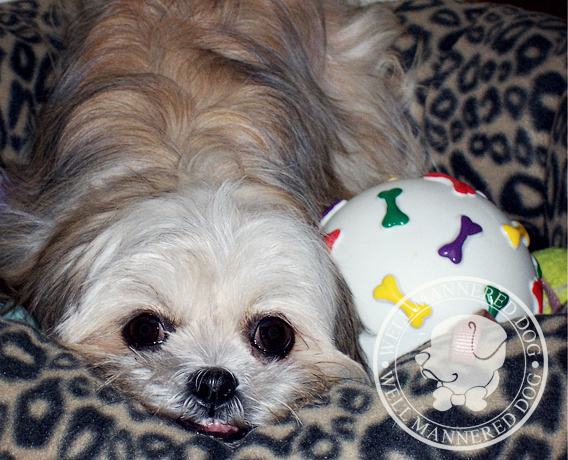
Make your dog training practice a part of your everyday life.
“I don’t have time to practice.” – almost everyone
I often am told that people simply do not have time to practice with their dogs. While setting aside time to spend one on one with your dog is ideal, I completely understand that sometimes life gets busy. We are, after all, human. Even though life is full of demands, your dog still needs repetition and consistency in order to develop the behaviors that you want in your canine companion. Most people that I work with, do not realize that nearly every second spent with their dog, whether set aside or not, is time spent training. Why not integrate your dog training practice into your daily routines so that you can make the most of your time and bond with your dog? There are lots of ways to do it. Here are just a few:
SIT and DOWN: Sit and down commands should be practiced whenever you need your dog to stop moving and freeze into position. Practice down and sit stays while you answer the door, read a magazine, or brush your teeth. Whenever your dog is moving around and you want them to stop, replace the negative behavior with a positive one. Utilize those commercial breaks! You will thank me later.
PLACE: Working on Place is easily to accomplish while you watch television, eat dinner or check your email! Start with short place challenges during commercial breaks and then when your dog gets better at it, extend out to actual show segments. Put them on place while you start reading your email, see how many you can get through before your dog tries to get up! While snuggling with your dog during your downtime is often a relaxing time for many owners, this is a way to get in your practice so that when guests come, they can be just as relaxed. Don’t forget, if you don’t practice, your dog is not going to remember what to do when you need it to. Be consistent!
WAITING: Even the simple act of going through a doorway is a great opportunities for integrated practice. Have your dog do a sit/stay or a down/stay and wait at doorways. You should always go through first. Have them sit/stay or down/stay while you put down their food. Release them from their stays with a “you’re through”. This way they understand that you own the food and they are motivated to listen!
Can you think of a way to integrate your dog training practice into your everyday life? Let me know! I’d love to read your ideas.
Get the Most out of Group Class
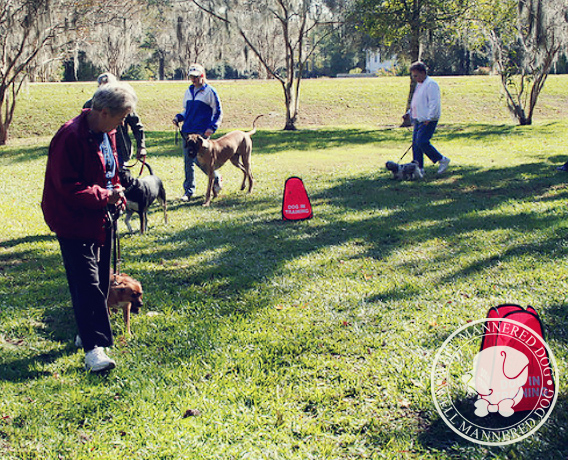
Bringing your dog to group class, after private training, will help bring out the best in them at home.
Are you a new graduate or have you missed out on the group class portion of your program? Our group classes offer a great opportunity to refresh your training, socialize your dog with other well mannered canines, and to be around other people who understand both dogs and the training process. So if you decide to attend, what should you bring with you to class? What should you expect to happen? How should you prepare? What if you are a group class veteran? How can YOU get the most out of class?
What to Bring to Group Class
When you are headed to group class, here is a list of items that you should bring:
- Your dog (If you would like to observe a class first to calm your own nerves, you may.)
- The collar that they are most used to wearing while working, or what your trainer suggested for class.
- Any training aids you use while working your dog.
- A pickup bag in the event your dog decides to go (many do).
- Water (for both of you) and a bowl for the dog
- A good attitude and an open mind
What to Expect
When you arrive at the meeting place, you will find a group of people with their dogs. These will be dogs of all sizes, who have gone through a variety of training levels. Some of them will be veterans of group class, others will be new, just like you! A trainer will arrive to guide the group through a series of exercises. Control walk, sit, down, stay, heel, and even come will be used in a variety of challenges. You will learn how to work your dog in an alternative environment and with distractions (the other dogs and their owners). There will be a five minute break in the middle of the class to offer the dogs a moment to relax, owners to interact, water to be consumed, and potty breaks to be taken.
You should know that many dogs get excited around the other dogs, and will be more challenging to work with than normal. Remember that this is the same for all dog owners, especially when they start out, and that everyone is paying more attention to their own dog and their own experience than to you. These classes are supposed to be fun and challenging, so try to keep a positive attitude and do not take yourself or your dog too seriously. These are learning experiences. Mistakes are required for progress!
Some dogs that attend have some social issues either with other dogs or other people and sometimes both. So do not allow your friendly pet to run up to other dogs without asking first. When the group session begins, the trainer will point out these circumstances. It is always a good idea to keep a leash distance between your dog and the others there.
For the Veterans
What if you have attended group classes in the past, and you don’t feel as though either of you are being challenged anymore? You should definitely still attend group classes! Tell the trainer that you are looking for additional challenges, and they will offer you different ideas of how to work both your and your dogs skills to a higher level. Here are a few ideas:
- With your trainer’s permission and advice, do some of the exercises off leash (dog dragging the leash or using a training tab).
- Use hand signals rather than verbal cues.
- Work on your dog paying attention to only you during the class.
Can your dog keep up? You may even find that there are multiple veterans in the class that can work with you to offer a greater challenge in a separate class, or through trainer-guided challenges. These classes are for YOU, be sure that if there is something that you want to work on or something you’d like to see, tell the trainer. We need to know what you are looking for to offer you the best service.
Ask about our advanced small group classes for an even greater challenge! Remember, as veterans with dogs who are successful in group class situations, you are one of the best motivators we have for the people who are new to class. Encourage people. Tell them your stories. Your ability to guide your dog through class, even without the elevated challenges, can be enough to motivate others to work harder with their dogs. Help them to achieve the same levels of success and companionship that your family enjoys!
5 New Year’s Dog Resolutions
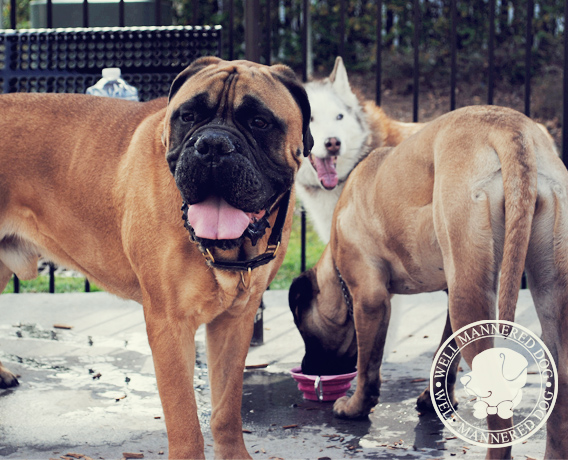
Choosing to set new year’s dog resolutions makes for happier dogs.
Dog resolutions can mean a better year for you and your dog.
- Walk Your Dog – One of your first dog resolutions should be to walk your dog. Walking your dog everyday will help you and your pet get into better shape. By using a control walk mixed with an occasional heel command, you will be reinforcing your dog’s place in the family.
- Obedience Training – Another important dog resolution is to either teach or brush up their obedience skills. If you haven’t already taught your dog the basics, it is never too late to start! If you know what to do, make sure you are being consistent. Resolve to spend 5-10 minutes every other day brushing up on your dog’s obedience skills. While you are at it, come to a few tune-up classes and really flex your leadership muscles.
- Annual Exam – Just like people, dogs need to have an annual check-up to make sure that everything is working properly and that there is nothing going on beneath the surface. Since symptoms can go unnoticed, a visit to your veterinarian’s office might be the key to catching something early. If your pet has not seen a veterinarian in the last year consider making an appointment for its physical exam.
- Socialization – If your dog isn’t given the opportunity to be around other dogs, then problems can arise. You might notice barking when you are out for a walk or other situations signaling your dog is uncomfortable. This can escalate into something more, so it’s always a good idea to allow your dog to socialize with other pets in a safe environment.
- Helping a Rescue Organization– What a great New Year’s dog resolution! Rescue organizations are always in need of volunteers, food and blankets, or monetary contributions. You can celebrate your dog by giving to an animal welfare organization.
Is Your Dog a Canine Good Citizen?
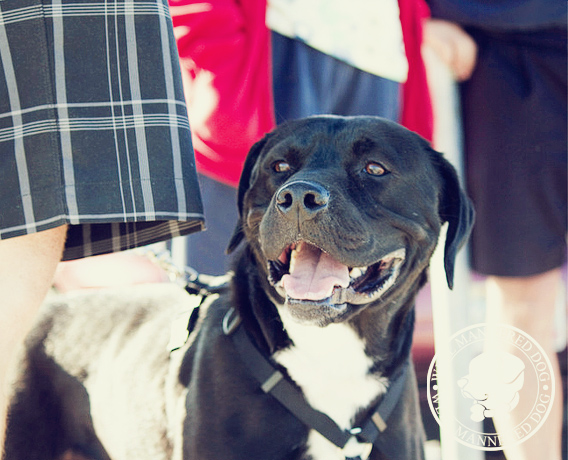
Passing the AKC Canine Good Citizen test is a good goal for all dogs and owners.
Canine Good Citizen Requirements
The American Kennel Club offers a Canine Good Citizen program designed to measure your dog’s social manners out in public with other dogs and humans. The testing evaluates several things your dog has been trained for, such as walking on a loose leash, meet and greets with dogs and people, basic commands, distraction work, separation with a trusted person and grooming. Upon passing the test, the American Kennel Club issues a certification formally acknowledging him as a Canine Good Citizen. The test is required by most therapy dog programs, and is a great foundation if you are interested in doing this type of work with your dog. The ten items on the Canine Good Citizen test are:
- Accepting a friendly stranger.
- Sitting politely for petting.
- Reaction to another dog.
- Reaction to distraction.
- Walking on a loose lead.
- Walking through a crowd.
- Appearance and grooming.
- Sit and down on command, and staying in place.
- Coming when called.
- Supervised separation.
Is Your Dog Ready?
Make sure your dog can accomplish the objectives not only in your home, but also in different environments with new distractions. Group Classes are the perfect place for this. In fact, let me know you are working towards this goal and I will specifically help you with some of the requirements. If your dog performs well at group class, that is a great first step in earning the certificate.
I am a certified Canine Good Citizen tester and would be happy to help you and your dog reach this goal. Please contact me for more information if you are interested in having your dog become a Canine Good Citizen.
For all rules and regulations, visit The AKC Site.
A Fun Way to Teach “Leave It”
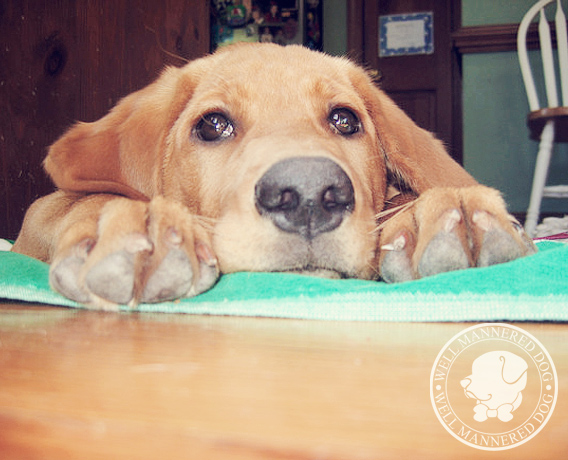
How can you say Leave It to this face?
The “Leave It” command can help prevent your dog from consuming something dangerous if taught correctly. Dogs are conditioned pretty early on that things on the ground are fair game. Do your dog and yourself a favor and take some time to teach your dog this life saving command.
- Create a “temptation zone” with a few of your dog’s favorite toys, some cheese cubes, a couple of treats, and various other taunting items strewn around the floor.
- Put a collar and leash on your dog before bringing it into the temptation zone.
- Walk the dog on a loose leash, but with just a slight amount of slack. You want to be able to move the dog’s direction quickly. Do NOT hold the leash tightly. This will send mixed signals to your dog.
- When your dog lowers its head to take an item, say “Leave It” and move the leash upward to stop the dog’s forward progress. This does NOT need to be harsh. Just use enough pressure to stop the dog from getting the reward. Make sure you say “Leave It” in a commanding tone (not yelling! just firm).
- Quickly switch directions and move away from the object the dog grabbed at.
- Praise your dog lavishly for leaving the temptation alone.
- Repeat this process until your dog is ignoring the temptations. Really praise the dog for following your command.
- At the end of your session, you may choose one of the rewards to give your dog. Make sure you pick it up and hand it to them. You never want to allow your dog to take it off the floor. By handing them the reward, your dog will see that it came from you and it will garner respect. Your dog will learn that the items are given on your terms.
Of course, there are several ways to teach this command, so if your dog is not getting it with this method, there is always a different way.
© 2013 Well Mannered Dog Training Charleston, SC
TAGS: Obedience Training, Positive Approach, Practice